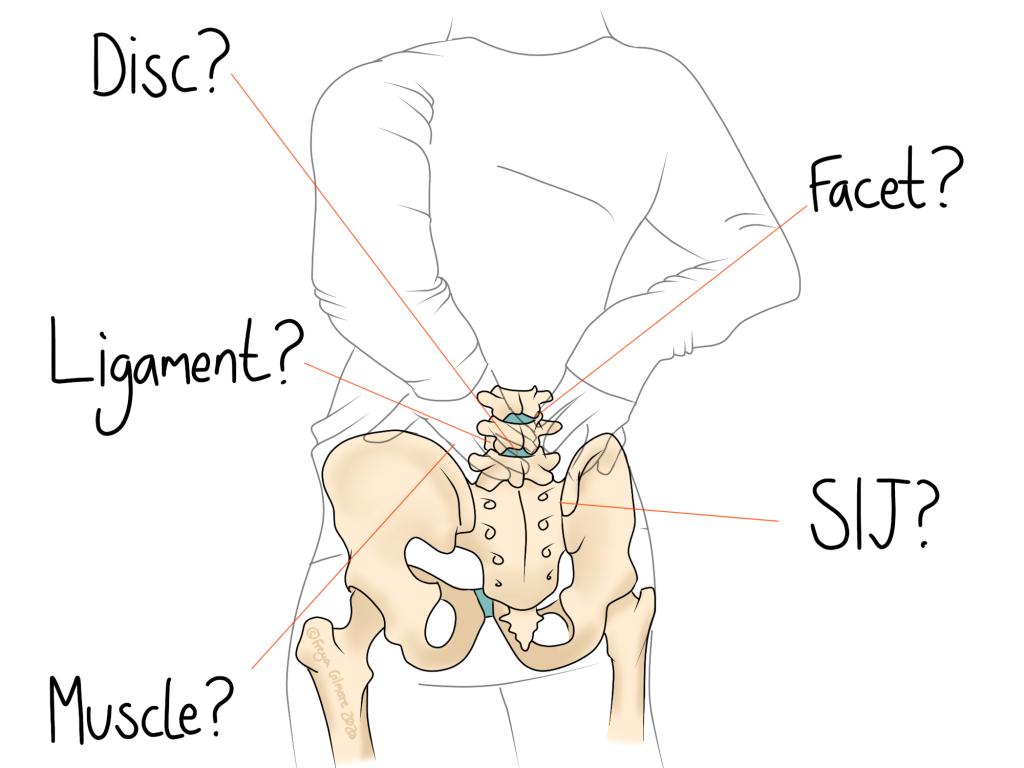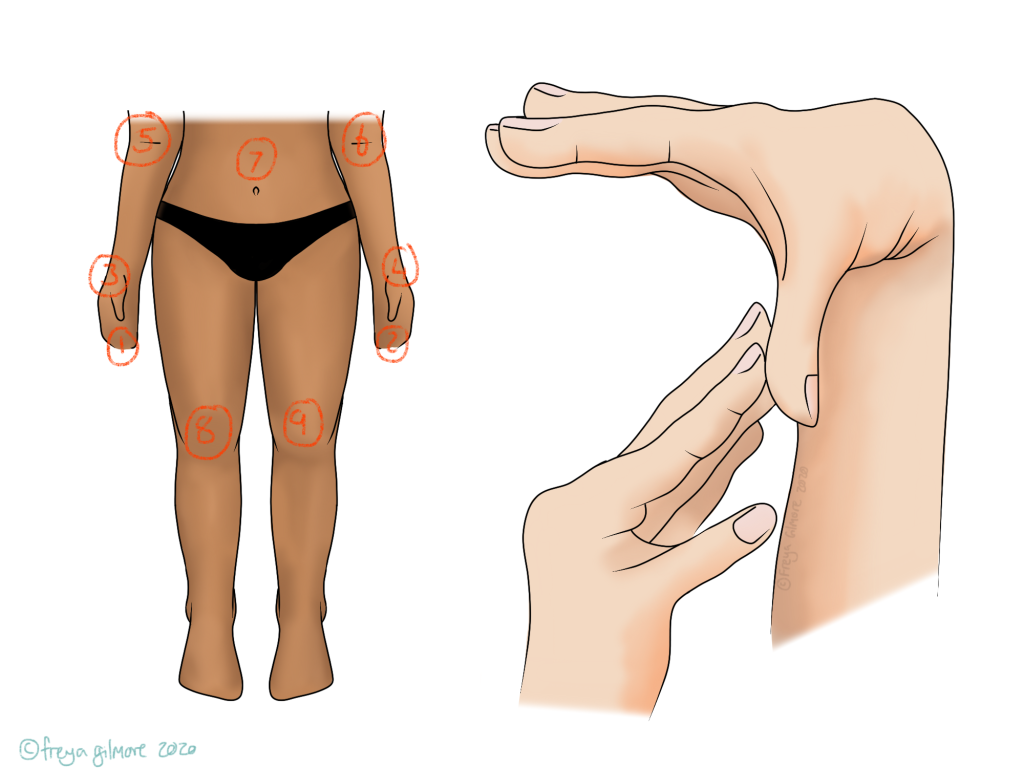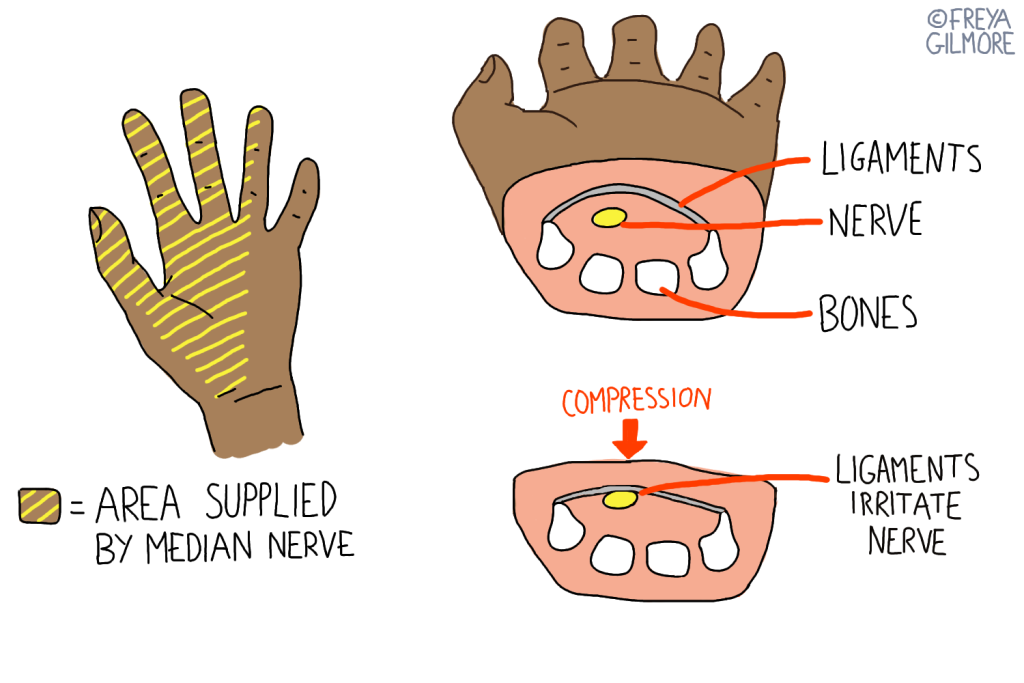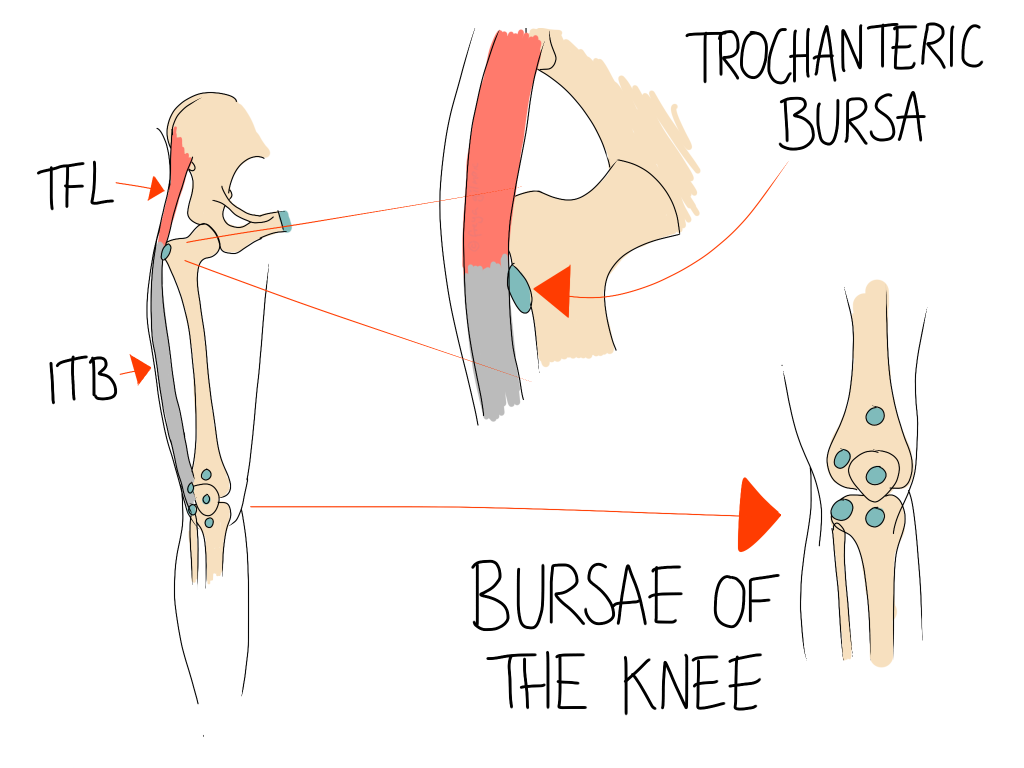See video below for a concise version of this blog

Non-Specific is probably not how you want anyone to diagnose you. Depending how the diagnosis of NSLBP is packaged, you might have questions like:
“Why can’t you tell me exactly what’s causing my pain?”
“Do I need an X-Ray or MRI done to find the cause then?”
“How can you treat it if you’re not sure what it is?”
Non-specific in this context does not mean “it could be anything”. In order to settle on a diagnosis of NSLBP, serious causes are ruled out through the case history and examination. These causes include:
- infection
- tumour
- osteoporosis
- fracture
- structural deformity (eg spondylolisthesis)
- inflammatory disorder (eg Ankylosing Spondylitis)
- radicular syndrome (eg sciatica/ “trapped nerves”)
- cauda equina syndrome
So NSLBP does not include “trapped nerves” or serious causes of back pain. It can also be called NSMLBP, where the “M” stands for “mechanical“.
Most episodes of low back pain are self-limiting and are not related to serious diseases. The clinician’s initial aim is to distinguish the small proportion of patients with specific underlying conditions—and sometimes life threatening disorders—or nerve root pain, from the vast majority with non-specific mechanical low back pain.
Lancet
Clinical Uncertainty
Clinicians have diagnostic tests at their disposal to supposedly differentiate between similar causes of pain. Theoretically all bulging discs should cause more pain when the patient bends forward, and if the joints of the spine are irritated, they should be aggravated by leaning back and to one side. But when these tests are examined, we see that they are neither 100% specific or sensitive. They can give both false positives and false negatives.
Evidence to suggest that the characteristics that purportedly define subgroups can be identified with good accuracy, or that a specific type of management is available for each subgroup, is insufficient.
Lancet
NSLBP may encompass disc, facet, muscle, SIJ, or ligament issues. It may be chronic or acute. These mechanical causes are affected by rest and movement, and may follow patterns throughout the day or in response to specific activities. The cause of pain is likely to be a combination of the above structures: for example an irritated facet joint causing nearby muscles to tighten up in an effort to protect the local area. So even if the clinical tests were more reliable, results would likely be skewed by interference from other causes.
Inaccuracies of Imaging
This uncertainty extends beyond clinical testing. It is not recommended to routinely image painful lower backs, because MRI findings are not totally in line with symptoms either. As before, there are lots of asymptomatic people with MRI results that look painful, and vice versa.
However, most guidelines advise that all imaging studies should be reserved for patients with progressive neurological deficit, or when serious underlying causes are suspected. When used without these indications, imaging does not improve clinical outcomes. The results of a systematic review of randomised trials of patients without red flags showed that in a subset of the trials that followed up all patients for more than 6 months, or imaged all participants, no serious diagnoses were recorded. Moreover, imaging can result in increased rates of surgery.
Lancet
Many conditions under NSLBP respond to very similar treatment. If the effect is the same, why be specific and wrong when you could be vague and right?
Actual risk factors for NSLBP
- Being overweight
- Having a sedentary lifestyle
- Doing strenuous work (all about balance)
- Having a genetic predisposition
- Having a previous history of lower back pain (nearly 50% of people)
The causes of NSLBP are multifactorial, so giving general preventative advice is tricky. However the first three risk factors can be managed by balance: stay at a healthy weight, move around throughout the day, and avoid long periods of work that is particularly strenuous. Exercise is the best form of prevention.
Mythbusting
- Your back pain is probably nothing to do with your mattress
- You probably can’t blame “getting older” (back pain improves again from mid 60s)
- Bed rest for a day or more is not recommended
- You probably don’t need fusion surgery, but an MRI might send you down that route anyway
- It’s probably nothing to do with your posture, but you will get sore if you stay in any one position for too long (“good” or “bad” positions will all cause this)
- Likewise, the link between NSLBP and a “weak core” is tenuous, including after caesarian.
However, eight systematic reviews with the Bradford-Hill causation criteria concluded that it was unlikely that occupational sitting, awkward postures, standing and walking, manual handling or assisting patients, pushing or pulling, bending and twisting, lifting, or carrying were independently causative of low back pain in the populations of workers studied.
Lancet
Management for NSLBP
It is against the Osteopathic Practice Standards to treat without a diagnosis. This is where NSLBP fills the gap between making a somewhat unsupported guess and not settling on anything at all.
A lot of NSLBP will resolve on its own, but seeing a professional for treatment, advice, and reassurance can speed up progress and reduce the chances of developing chronic lower back pain. Your osteopath may also be able to identify predisposing factors and work with you to minimise them, therefore preventing or limiting further episodes of pain.
For acute low back pain, most clinical practice guidelines agree on the use of reassurance, recommendations to stay active, brief education, paracetamol, non-steroidal anti-inflammatory drugs, spinal manipulation therapy… Some reviews recommend topical pharmacological treatments and superficial heat application for pain relief. Systemic corticosteroids are not recommended for acute low back pain
Lancet
Chronic Lower Back Pain
One of the biggest factors in acute NSLBP becoming chronic (lasting over 12 weeks) is outlook. 10-15% of cases become chronic. A good understanding that there is nothing serious to cause the pain greatly affects pain. Patients often feel better as soon as they’ve been listened to and given a diagnosis. Receiving structured information about safe movements, exercise, and self management are also empowering methods to combat pain. Your osteopath is there to support you throughout your episode of back pain, and can direct you to your pharmacy or GP with a letter should medications be required.
For chronic low back pain, the use of brief education about the problem, advice to stay active, non-steroidal anti-inflammatory drugs, weak opioids (short-term use), exercise therapy (of any sort), and spinal manipulation are recommended in most guidelines. Self-management strategies—for example health-promoting activities, self-monitoring of status, and decision-making—are receiving increasing attention as important components in the management of low back pain.
Lancet
If your back is causing you problems, you can book an appointment with me here for Milton Keynes or Buckingham.



